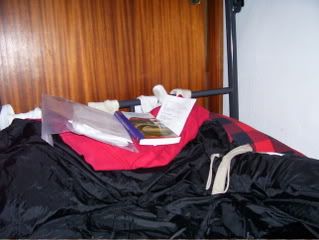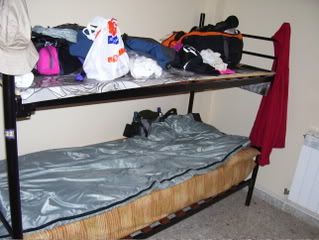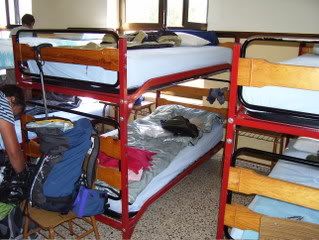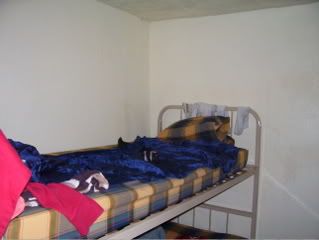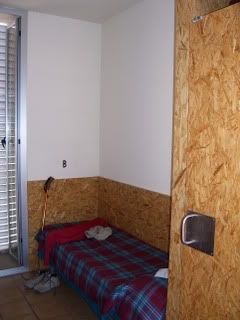San Juan de Ortega: No, I did not stay here (having read the guide books), but I did speak to 3 people who did. One insisted the albergue has hot water, the others said it did not. Two of them did not take a shower there because of the state of the bathrooms. All of them liked the pilgrim service & the garlic soup. All of them also agreed that the bathrooms were very dirty. This is a damn shame in my book because the church there is one of the most special, most holy-feeling, churches I poked around in.
Atapuerca:I had been worried about my knees, so I was not looking forward to the "steep climb" out of Villafranca. They are not kidding about that, BUT it's not as long as I had thought it would be. Word of caution: Make sure you have your own water. The sign at Fuente Mojopan is an "Agua Non Potable" sign, but the "Non" part has been painted over. Sort of. If you want to take your chances, feel free, but I'm not willing to gamble on something like that. There also is no descent to Valdefuentes, as the Camino has been restructured, widened, and levelled out. I made San Juan de Ortega by 11!!! But, you have been warned. Fill up in Villafranca.

We stayed at the private Albergue de Peregrinos on the main road in Atapuerca. Very nice, clean, smallish kitchen, but we only threw breakfast together there. The rooms have 2 beds & two bunk beds in them. Each bed has a small shelf for your personal night time items, and a footlocker for your pack. IIRC, there is also a plug so you can recharge your phone/iPod/electrical entertainment device of your choice while you sleep. The internet connection is in the Information Center of the Archaeological Center just down the road. It's free, but there's only one terminal, so if someone's already on there blogging away, you have to sit & wait your turn. Which isn't bad, since you can watch the film of the exacavations underway in Atapuerca & learn something. Evidence suggests that this area has been inhabited by humans &/or humanoids for almost 1 million years. This albergue also posts information on which bus to take into Burgos.
Burgos (at last):I was only a few months' late getting to Burgos (my first stab at the Camino was to end here instead of Logrono). This was also the only day the heavens opened up & it rained like cats & dogs (with nasty-sounding thunder & lightning thrown in for good measure). After waiting out the storm in a small bar, we headed towards Villafria. Note: The guidebooks mention a plethora of routes--this has been changed. The only alternate route we saw was the turn off after crossing the highway just before Villafria.
Instructions for taking the bus into Burgos: The route you are looking for is route 8. It stops in front of the Buenos Aires hotel/restaurant every hour on the hour between the hours of 10 a.m. & 2 p.m. (times according to the albergue in Atapuerca; we hopped on the noon bus, so I can't vouch for the other times). Cost is 75 cents (Euro) & well worth it. This route ends near the statue of El Cid, close to the Cathedral.
None of us stayed at the main albergue in Burgos. The first night, I stayed at Hotel Espana for 35 Euro/night. Nice place, but I checked out the next day with the intention of going to the main albergue in the park. My friends stayed at the small albergue near the cathedral. They saw people being turned away because they were not walking the next day. (Hello, most pilgrims take a rest day in Burgos!) They were not allowed to do laundry because it had been raining. It was also crowded, but for a donativo, who's going to complain?
The next day, I checked out of the hotel & headed towards the Cathedral plaza. I met up with 2 German pilgrims & somehow in German, French, Spanish AND English, I gathered that the main albergue was "very bad, don't go there." I somehow a referral for a good pensione for the Germans, since they didn't want to stay at a hotel. It's amazing what information you can get using 4 languages (including 2 that no one is fluent in), maps, & charades. So there I was in the middle of Burgos with no place to rest my weary head for that night. I took a look around & decided to take a chance on Meson del Cid. It is a 4 star, so I was sure it was too pricey, but I was also armed with my American Express card. Yes, they took Amex & would I like a room for 70 Euro (no meals) or 90 Euro (meals included). For the record, if you are in Burgos on a Tuesday evening, take the 90 Euro offer. Most restaurants were closed Tuesday evening, so I would have saved a bunch if I had been smart enough to follow my instincts. After all the albergues & the 2 star hotels, this place was Paradise! A nice big bed all to my lonesome, TV with CNN International (although the only story of import was OJ's recent arrest, so I'm not sure if this was a great deal or not), and a big bathroom. Later that day (after discovering that most restaurants were closed), I ran into Mes Amies again, & as luck would have it, they were also staying at the same hotel!!!! We ended up walking together all the way to Fromista. We had dinner that night in the hotel's restaurant. Expensive, but OMG, it was worth it!
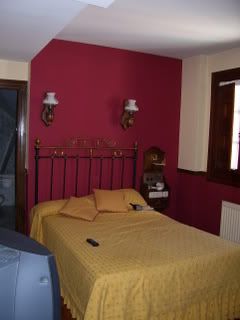
We took the bus out of Burgos as well, but since I was following Mes Amies (they had the instructions), I can only suggest that you inquire at the Information office near the Cathedral.
Hornillos del Camino: We almost didn't get beds here, but got the last ones, including 2 lower bunks. The bathrooms were clean, as were the dorms. The kitchen was also clean. The only downside was the very small laundry area. Only one small sink, so the line for laundry was longer than the line for the shower.
There is a store here & it is open during siesta & until 8pm. I'm not sure if it's open all year. It is fairly well stocked for a town of this size (less than 100 people) & has bathrooms. It is owned (I think) by the same people who own the bar/restaurant in front of the albergue. Word of caution: while it is great that they start serving dinner so early (6:00), you have to go put your name on a list. There are only 5 tables & we had to wait almost 2 hours. Nice upshot to that was since they are also the hospitaleros, the bar owners don't close up the albergue until everyone has had dinner. There is a hotel of sorts in town as well, but Hornillos fills up quickly.
